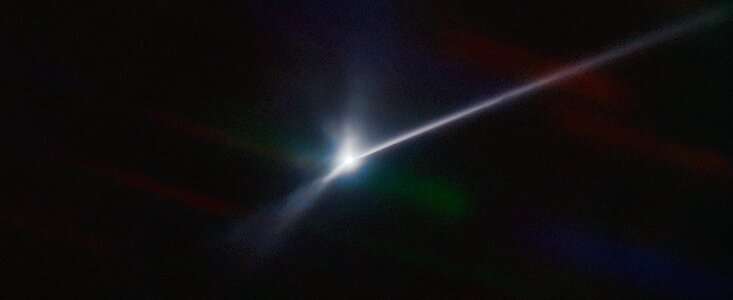SOAR Telescope catches Dimorphos’s expanding comet-like tail after DART spacecraft impact

NASA’s Double Asteroid Redirection Test (DART) spacecraft intentionally crashed into Dimorphos, the asteroid moonlet in the double-asteroid system of Didymos, on Monday, 26 September 2022. This was the first planetary defense test in which an impact of a spacecraft attempted to modify the orbit of an asteroid.
Two days after DART’s impact, astronomers Teddy Kareta (Lowell Observatory) and Matthew Knight (US Naval Academy) used the 4.1-meter Southern Astrophysical Research (SOAR) Telescope at NSF’s NOIRLab’s Cerro Tololo Inter-American Observatory in Chile to capture the vast plume of dust and debris blasted from the asteroid’s surface. In this new image, the dust trail—the ejecta that has been pushed away by the sun’s radiation pressure, not unlike the tail of a comet—can be seen stretching from the center to the right-hand edge of the field of view, which at SOAR is about 3.1 arcminutes using the Goodman High Throughput Spectrograph. At Didymos’s distance from Earth at the time of the observation, that would equate to at least 10,000 kilometers (6,000 miles) from the point of impact.
“It is amazing how clearly we were able to capture the structure and extent of the aftermath in the days following the impact,” said Kareta.
“Now begins the next phase of work for the DART team as they analyze their data and observations by our team and other observers around the world who shared in studying this exciting event,” said Knight. We plan to use SOAR to monitor the ejecta in the coming weeks and months. The combination of SOAR and AEON is just what we need for efficient follow-up of evolving events like this one.”
These observations will allow scientists to gain knowledge about the nature of the surface of Dimorphos, how much material was ejected by the collision, how fast it was ejected, and the distribution of particle sizes in the expanding dust cloud—for example, whether the impact caused the moonlet to throw off big chunks of material or mostly fine dust. Analyzing this information will help scientists protect Earth and its inhabitants by better understanding the amount and nature of the ejecta resulting from an impact, and how that might modify an asteroid’s orbit.
SOAR’s observations demonstrate the capabilities of AURA facilities in planetary-defense planning and initiatives. In the future, Vera C. Rubin Observatory, currently under construction in Chile, will conduct a census of the solar system to search for potentially hazardous objects.
Didymos was discovered in 1996 with the UArizona 0.9-meter Spacewatch Telescope located at Kitt Peak National Observatory, a program of NSF’s NOIRLab.
‘Incredible’: Astronomers hail first images of asteroid impact
Citation:
SOAR Telescope catches Dimorphos’s expanding comet-like tail after DART spacecraft impact (2022, October 3)
retrieved 3 October 2022
from https://phys.org/news/2022-10-soar-telescope-dimorphos-comet-like-tail.html
This document is subject to copyright. Apart from any fair dealing for the purpose of private study or research, no
part may be reproduced without the written permission. The content is provided for information purposes only.
For all the latest Science News Click Here
For the latest news and updates, follow us on Google News.

